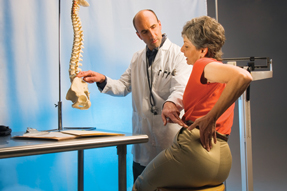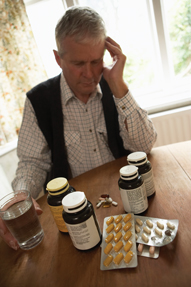Opioid abuse potential prompts monitoring role for internists
Opioids can be used safely for pain management in most patients, but for a small but significant percentage, there is a real chance of addiction and other harms. Experts increasingly look to the prescribed drugs in a medicine cabinet as a source of concern.
Opioids can be used safely for pain management in most patients, but for a small but significant percentage, there is a real chance of addiction and other harms. From 1999 to 2007, the number of poisoning deaths involving any opioid analgesic more than tripled from 4,041 to 14,259, according to the National Center for Health Statistics.
Many pain and substance abuse experts feel the situation demands a change of emphasis in the various guidelines that exist for opioid use, particularly for chronic noncancer pain, such as those published by the Federation of State Medical Boards, said Leonard Paulozzi, MD, MPH, an epidemiologist at the Centers for Disease Control and Prevention who specializes in research on prescription drug abuse.

Dr. Paulozzi cited Physicians for Responsible Opioid Prescribing, which recently offered guidelines that are much more cautious, estimating that between 4% and 26% of patients on chronic opioid therapy have an opioid use disorder.
“Doctors really should not initiate chronic opioid therapy before considering safer alternatives,” he said, including non-opioid painkillers, cognitive behavioral therapy and physical therapy. (See “Internists don't need to defer treating pain “ for more on approaches to pain management.)
Universal monitoring
According to Daniel Alford, FACP, MPH, an internist at Boston Medical Center and associate professor at Boston University School of Medicine who is a specialist in addiction medicine, all patients have potential risk for misusing opioids, so therefore all patients should be monitored.
Theodore Parran, Jr., FACP, an internist and addiction expert at Case Western Reserve University School of Medicine in Cleveland, agreed, saying he believes the rise of accidental fatal overdoses, which closely follows the increase in opioid prescribing, is partly due to physicians' lack of ability and willingness to screen for the 10% to 15% of the population who have addictive disease. This group, he said, has a substantial likelihood of developing a pathologic “sort of love relationship” with opioids.
Many people are undertreated for pain because some doctors are fearful of prescribing controlled drugs, Dr. Parran said. However, ironically, doctors often unknowingly continue prescribing drugs to the very patients who are abusing or misusing because they push hardest for the medications.
Dr. Alford believes the conversation with a patient about monitoring should happen when the decision is first made to prescribe opioids.
At that point, he said, people are open to discussions about risks and benefits and the need for careful monitoring. If the doctor waits to discuss monitoring until a patient exhibits worrisome signs of opioid misuse, he said, the conversation will likely be confrontational because the patient feels singled out.
Dr. Alford advises physicians to tell patients that the monitoring is routine and universally applied, saying, “Listen, the way I can protect you from any harm from these medications is to monitor you.” He tells his patients that if he starts to notice worrisome behaviors, such as running out of pills early or losing a prescription, he may need to try a different therapy to treat their pain and possibly refer them to addiction treatment.
The CDC's Dr. Paulozzi said it's important to warn patients that it might be difficult to stop opioids, particularly if they get up to higher dosages, and to discuss the goals, risks and realistic expectations of benefits. He also said doctors should get a urine drug screen on a patient before starting opioid therapy to determine whether the person has an illicit drug problem or is getting prescription drugs elsewhere.
Jeffrey Samet, FACP, MPH, an addiction expert at Boston University School of Medicine, acknowledged that these initial conversations can be difficult, especially when doctors inherit patients who are already taking an opioid. But help is available from more experienced professionals, he said, and it's worth tackling the issue rather than becoming a patient's continuing drug source.
Contracts/agreements convey message
Patients starting opioids should sign an agreement stating how their doctor will monitor them, including urine drug testing, pill counts and checking prescription histories in the state prescription monitoring program where available, said Dr. Alford and other experts. The contract Dr. Samet uses also states that the patient will notify the practice if narcotic pain medications are prescribed from another physician and that the practice may check with other doctors to ensure the patient is not getting pain medications elsewhere.
“Contracts are useful because they communicate the gravity of the situation,” said Westley Clark, MD, JD, head of the federal Center for Substance Abuse Treatment at the Substance Abuse and Mental Health Services Administration (SAMHSA).
Model contracts are available online. And over the next year, the Food and Drug Administration's Safe Use Initiative will begin to consider how to make those contracts better and more educational for the patient. The initiative began in 2009 to facilitate public-private collaborations with the health care community to reduce preventable harm from medications.
Monitoring options
Monitoring patients while they are on opioids can be time consuming and resource-intensive, but Dr. Alford argued that doctors perform extensive monitoring for efficacy and safety with other medications such as insulin or warfarin.
Regular urine drug testing should be done during treatment to ensure the patient is taking the prescribed medication, not selling or giving it away, and is not taking other substances not prescribed, he said.
He cautioned that interpreting urine drug test results can be complicated. Doctors need to understand there can be false-positives and false-negatives, and it is often helpful to consult a toxicologist or a clinical pathologist with questions about which medications can cross-react, he said.
Doctors can use pill counts to try to ensure that patients are taking the medication as prescribed and not selling it. But physicians also must recognize that nothing is 100% fail-safe, as patients who are selling their pills are smart enough to know how many pills they should have left, and that sometimes they honestly forget to bring the pills, Dr. Alford said.
Thirty-four states have prescription monitoring programs that allow a physician to access a patient's prescription history for many problematic drugs. Ten others have laws enacted to create such programs. However, Dr. Paulozzi noted, surveys show only about 20% of doctors who prescribe controlled substances look up their patients with such systems.
“The physician who does not check the prescription monitoring program—and the patient overdoses on medication associated with doctor-shopping—puts himself or herself in an awkward position,” said Dr. Clark of SAMHSA.
Dr. Paulozzi encouraged all doctors, especially those about to start a patient on long-term therapy, to use the systems, which have become more user-friendly with faster updates and Web access.
For people at higher risk of opioid misuse, including addiction, such as those with current substance abuse, a personal or family history of substance use disorder, or a history of mental health issues or legal problems, physicians might want to consider more intensive monitoring, with more frequent urine drug tests and pills counts, Dr. Alford advised. The highest level of monitoring would mean calling patients randomly and asking them to come in within 48 hours for a urine drug test and a pill count.
If Dr. Alford feels patients have developed an addiction to a prescription opioid, he will try to convince them they need help. But often they say they just need more of the drug to treat their symptoms. Dr. Alford will often taper them down slowly, continuing to try to engage them in the conversation about addiction treatment.
In severe cases, he rapidly tapers the medication and tells patients he will be happy to refer them to a detox program. Sometimes, he said, he and the patient may have to agree to disagree on the addiction diagnosis. He makes it clear that he is not discharging the patient, but that he is discharging the ineffective or harmful opioid therapy for this given patient. He tells patients to let him know if they change their minds about accepting an addiction treatment referral.
It's important for a physician to realize that effective addiction treatment for their patients is available, said Dr. Samet. Options include methadone, which is usually given at least initially in structured addiction programs, and the newer buprenorphine, which may be dispensed or prescribed by physicians who have had the special training to do so.
But in addition, Dr. Alford said, addicted patients need some form of counseling to deal with environmental triggers to relapse, such as stressful social situations or contact with friends who may still be using—issues “that, frankly, doctors are not great at dealing with.”
A skilled addiction counselor can be incredibly helpful, he said. At a minimum, Dr. Alford asserted, every addicted patient should be encouraged to go to 12-step program meetings such Narcotics Anonymous or Alcoholics Anonymous, which are free and readily available in most communities, he noted.
For all chronic pain patients on opioids, he tells doctors to carefully document that they are seeing some benefit in pain and function and that they are using the tools available to monitor for any harm.
“You do the best that you can by using all the tools at your disposal,” he said. “You are not going to be able to 100% avoid causing problems such as opioid misuse. You are not going to be able to prevent 100% of people who are determined to give away or sell some of their medications. However, you can certainly decrease the likelihood of these bad outcomes continuing unrecognized and unabated.”





